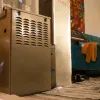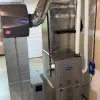If you heat your home with an electric heat pump, you may have seen an “auxiliary heat” mode on your thermostat. It usually only turns on during the coldest days and nights of the year.
Some thermostats display it as “aux heat.” Others will say “emergency heat.” Either way, you’re probably wondering what auxiliary heat means.
Well, there’s a short answer and a long answer. Here’s the short one:
Auxiliary heat refers to the electric heat strips inside your heat pump system air handler. When the heat pump can’t satisfy your thermostat setting on its own, it will activate these heat strips to ensure your home stays warm.
Heat strips are an auxiliary, or secondary, heat source. Most of the time, your home’s heat pump will handle all of the heating. But when it can’t keep up, the heat strips turn on to make up the difference.
You don’t want to use auxiliary heat unless you have to.
The heat strips inside your air handler are very energy inefficient. They’re just flat-out expensive to operate and will increase your utility bills every time they turn on.
Nobody wants that, so why have heat strips at all? Here are two reasons:
1. Most heat pumps perform poorly on very cold days
A heat pump works by removing air from the outdoors and transferring it to your home’s interior. It’s like an air conditioner, only it works in reverse.
It’s a pretty efficient way to heat your home! Until outdoor temperatures dip into the 30s. At that point, your heat pump may start to struggle.
When your heat pump can’t heat your home to your desired temperature on its own, heat strips are a great thing to have! They’ll turn on and bring your indoor temperature up to whatever you’ve dialed in on the thermostat.
Even here in Atlanta, it’s common to experience nighttime temperatures in the 20s and even the teens from December through February. Unless you’re keen on shivering through the night, you’ll be glad those heat strips are there to keep you toasty!
2. You need to raise the temperature by several degrees, fast
Imagine it’s the first week of January. You were just away visiting family for the holidays, but now you’re arriving home from the airport. To save on utility costs while you were away, you lowered the thermostat to 62 degrees. Smart move.
But now you’re back, and you don’t want to hear about how the house is too cold! Your family wants that thermostat set back to 70 – and soon.
If you bring your thermostat up to 70 from 62, you can almost guarantee your heat strips will kick on right away. That’s because your heat pump isn’t able to raise the home’s temperature by 8 degrees all on its own with outdoor temperatures in the 30s. It needs the heat strips to get the temperature where it needs to be.
After that, the heat pump will mostly be capable of maintaining that temperature without the auxiliary heat when outdoor temperatures are above freezing. Anything below freezing and the heat strips will probably keep turning on periodically.
How to prevent auxiliary heat from turning on
If you’re not keen on getting a power bill that makes you jump up and scream, you probably want to minimize your home’s use of auxiliary heat. But how?
The first way is to keep your thermostat in the mid-to-high 60s, not the 70s. The higher the temperature setting on your thermostat, the greater your home’s heating load. And the greater the heating load, the more often you’ll need auxiliary heat.
Another way is to avoid rapid temperature increases at your thermostat. In our returning-from-the-holidays example from above, you could try just raising the temperature by two degrees at a time. The heat strips probably won’t turn on! Then, when the heat pump has satisfied your thermostat setting, bump it up another two degrees. And so on.
Don’t like auxiliary heat? Here’s the fix.
The best way to avoid having to use auxiliary heat is to install a gas furnace the next time you need to replace the system. Gas furnaces can heat your home effectively no matter the outdoor temperature, and they’re much more efficient than heat strips during the coldest months of the year.
Another option — many consider it a best of both worlds choice — is to use a dual fuel system. Dual fuel systems use a heat pump when it’s cold and a gas furnace when it’s really cold! That way, you get the efficiency of a heat pump and the efficiency of a gas furnace instead of heat strips when the heat pump can’t keep up.
But you might not have gas lines running to your home. If that’s the case, you might be happy to learn that today’s electric heat pump systems are far more efficient than whatever it is you’re replacing! Compared to systems from a decade ago, today’s heat pumps are far more capable of efficiently heating your home at lower outdoor ambient temperatures.
Does that mean newer units don’t still have auxiliary heat? No. They do. But you probably won’t have to use it as often.
Or you could always get the heat pump from the future…
Mitsubishi recently started producing mini-split heat pumps that are designed to provide heat even when outdoor temperatures dip to -13 degrees Fahrenheit. They’re called Hyper-Heating H2I® units. They don’t contain heat strips because they don’t need them!
Of course, Mitsubishi’s products are mini-split systems, which are typically installed for additions, retrofits, or supplemental heating and cooling. You certainly can outfit your whole house with mini splits, but most homeowners in our area are pretty set on using the ductwork and HVAC infrastructure they’ve already got.
Still, the advent of Hyper-Heating H2I® bodes very well for the future of heat pump efficiency!
Concerned about auxiliary heat or emergency heat on your thermostat? We can help.
At PV Heating, Cooling & Plumbing, we service electric heat pumps at homes all over Metro Atlanta. If you’re concerned about your heat pump unit, get in touch with us! We’ll send someone out to address the problem ASAP.






